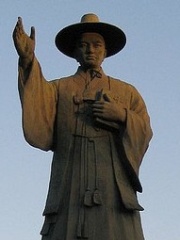
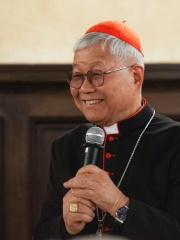
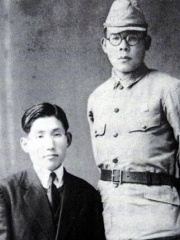
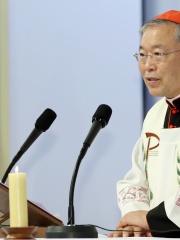
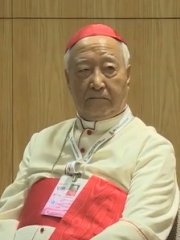
The Most Famous
RELIGIOUS FIGURES from South Korea
This page contains a list of the greatest South Korean Religious Figures. The pantheon dataset contains 3,187 Religious Figures, 6 of which were born in South Korea. This makes South Korea the birth place of the 53rd most number of Religious Figures behind Uzbekistan, and Morocco.
Top 6
The following people are considered by Pantheon to be the most legendary South Korean Religious Figures of all time. This list of famous South Korean Religious Figures is sorted by HPI (Historical Popularity Index), a metric that aggregates information on a biography's online popularity.

1. Andrew Kim Taegon (1821 - 1846)
With an HPI of 66.73, Andrew Kim Taegon is the most famous South Korean Religious Figure. His biography has been translated into 28 different languages on wikipedia.
Andrew Kim Taegon (21 August 1821 – 16 September 1846), also referred to as Andrew Kim in English, was the first Korean Catholic priest and is the patron saint of Korean clergy.

2. Lazarus You Heung-sik (b. 1951)
With an HPI of 64.90, Lazarus You Heung-sik is the 2nd most famous South Korean Religious Figure. His biography has been translated into 22 different languages.
Lazarus You Heung-sik (or Lazzaro; Korean: 유흥식; born 17 November 1951) is a South Korean prelate of the Catholic Church who has served as Prefect of the Dicastery for the Clergy since 2021. He is the first Korean to head a department of the Roman Curia. He previously served as Bishop of Daejeon from 2005 to 2021, after two years as a coadjutor bishop under Bishop Joseph Kyeong Kap-ryong. You was created a cardinal by Pope Francis in 2022.

3. Stephen Kim Sou-hwan (1922 - 2009)
With an HPI of 64.31, Stephen Kim Sou-hwan is the 3rd most famous South Korean Religious Figure. His biography has been translated into 23 different languages.
Stephen (often rendered as Latin Stephanus) Kim Sou-hwan (Korean: 김수환 스테파노; Hanja: 金壽煥 스테파노; July 2, 1922 – February 16, 2009) was a Korean prelate of the Catholic Church and the Korea's first elevated to the rank of cardinal. He is a former archbishop of Seoul, South Korea. Having been an iconic figure in South Korea's bloody and tumultuous transition from military rule to democracy, he was widely respected across all sections in South Korean society. He is venerated by the Roman Catholic Church having been declared Servant of God by Pope Francis.

4. Andrew Yeom Soo-jung (b. 1943)
With an HPI of 63.88, Andrew Yeom Soo-jung is the 4th most famous South Korean Religious Figure. His biography has been translated into 25 different languages.
Andrew Yeom Soo-jung (Korean: 염수정; Hanja: 廉洙政; born 5 December 1943) is a Korean prelate of the Catholic Church who was the Archbishop of Seoul from 2012 to 2021, while also holding the title of Apostolic Administrator of the Diocese of Pyongyang in North Korea. Pope Francis made him a cardinal in 2014. He was also the chairman of Catholic Peace Broadcasting Corporation (CPBC).
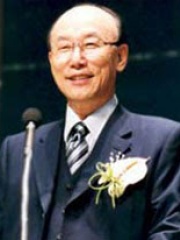
5. David Yonggi Cho (1936 - 2021)
With an HPI of 63.31, David Yonggi Cho is the 5th most famous South Korean Religious Figure. His biography has been translated into 19 different languages.
David Yonggi Cho (Korean: 조용기; 14 February 1936 – 14 September 2021 as Paul Yungi Cho) was a South Korean Pentecostal Pastor. He was the founder of the Yoido Full Gospel Church (Assemblies of God), which he started in a tent with 5 people (including his future mother-in-law Choi Ja-shil and her children as its first members), which eventually became the world's largest congregation, with a membership of 830,000 (as of 2007).

6. Nicholas Cheong Jin-suk (1931 - 2021)
With an HPI of 58.95, Nicholas Cheong Jin-suk is the 6th most famous South Korean Religious Figure. His biography has been translated into 23 different languages.
Nicholas Cheong Jin-suk (Korean: 정진석; Hanja: 鄭鎭奭; 7 December 1931 – 27 April 2021) was a South Korean Cardinal of the Roman Catholic Church. He served as Archbishop of Seoul from 1998 until he retired in 2012. He was previously Bishop of Cheongju from 1970 to 1998. He was made a cardinal in 2006.
People
Pantheon has 6 people classified as South Korean religious figures born between 1821 and 1951. Of these 6, 2 (33.33%) of them are still alive today. The most famous living South Korean religious figures include Lazarus You Heung-sik, and Andrew Yeom Soo-jung. The most famous deceased South Korean religious figures include Andrew Kim Taegon, Stephen Kim Sou-hwan, and David Yonggi Cho.
Living South Korean Religious Figures
Go to all RankingsDeceased South Korean Religious Figures
Go to all RankingsAndrew Kim Taegon
1821 - 1846
HPI: 66.73
Stephen Kim Sou-hwan
1922 - 2009
HPI: 64.31
David Yonggi Cho
1936 - 2021
HPI: 63.31
Nicholas Cheong Jin-suk
1931 - 2021
HPI: 58.95
Overlapping Lives
Which Religious Figures were alive at the same time? This visualization shows the lifespans of the 4 most globally memorable Religious Figures since 1700.

